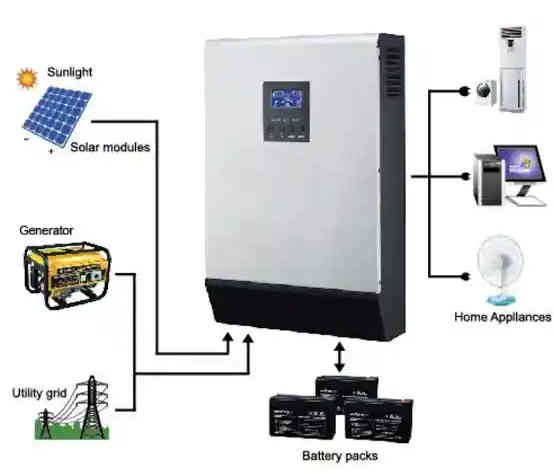Is it safe to use a hybrid solar inverter on a generator?
Hybrid inverters are essential for managing solar energy, batteries, and backup power in Nigerian homes and businesses. They intelligently switch between solar power, battery storage, and sometimes grid supply.
However, a common and dangerous mistake is connecting hybrid inverters directly to the grid or generator. TJ News Nigeria reports that such connections frequently lead to equipment damage, reduced battery lifespan, unstable power, and serious safety risks.
For safe operation, the grid and generator should always be separate from the inverter inputs, and batteries should be charged only via PV solar panels connected to the inverter.
1. Risk of System Overload
Hybrid inverters are designed to handle specific input voltages and currents. Connecting directly to the grid or generator can exceed these limits, causing:
- Inverter shutdown
- Blown fuses
- Permanent damage to internal electronics
Attempting to draw from multiple AC sources simultaneously stresses the inverter beyond its designed capacity.
2. Electrical Fire Hazard
Direct connection to unstable sources like the Nigerian grid or a generator can cause short circuits or overheating. Sparks and heat buildup may lead to house fires, particularly in installations without proper protection.
Pay Attention To: Best Solar Battery Options for Nigerian Homes (Latest Update)
3. Battery Damage
Hybrid batteries are designed for regulated DC charging from solar PV panels. Using grid or generator AC to charge batteries can:
- Overheat batteries
- Cause overcharging
- Reduce battery lifespan or permanently damage them
This undermines the core purpose of a hybrid solar system.
4. Equipment Warranty Voids
Most hybrid inverter manufacturers prohibit direct AC connections from unauthorized sources. Any damage resulting from such connections voids warranties, leaving the user responsible for costly repairs.
5. Risk of Electric Shock
Connecting the grid or generator directly to the inverter increases the risk of backfeeding electricity, which can cause:
- Severe electric shocks
- Injury or death to users or utility workers
- Damage to household appliances
Proper isolation using a manual or automatic changeover switch is essential for safety.
6. Unstable Power Supply
Hybrid inverters connected to multiple AC sources may constantly switch inputs, resulting in:
- Voltage fluctuations
- Flickering lights
- Appliance damage (TVs, computers, refrigerators)
The inverter’s job is to stabilize power, but improper connections defeat this function.
7. Generator Conflicts
When a generator is connected directly, it may produce reverse current flow, which can:
- Burn internal components of the inverter
- Damage the generator alternator
- Cause fire or explosion risks
Generators should always be connected through a proper transfer or changeover switch.
8. High Repair Costs
Repairs for inverters damaged by grid or generator connections are expensive. Critical components like control boards, MOSFETs, and capacitors often need replacement. In some cases, repairs cost nearly as much as a new inverter.
9. Energy Loss
Using the grid or generator to charge batteries defeats the purpose of renewable solar energy. Solar PV panels provide free, clean electricity, while relying on grid or generator power increases your electricity bills unnecessarily.
10. Safety Code Violations
Improper AC connections violate Nigerian electrical safety codes, which can result in:
- Disconnection by electricity distribution companies (DisCos)
- Denial of insurance claims in case of fire
- Legal penalties for unsafe installation
✅ Safe Practices for Nigerian Hybrid Inverter Users
- Keep the grid and generator separate from the inverter input.
- Use a manual or automatic changeover switch when switching between AC sources.
- Charge batteries only from PV solar panels connected to the inverter.
- Follow manufacturer installation guidelines closely.
- Engage qualified installers for setup and maintenance.
- Ensure proper grounding and surge protection.
- Test the system without load first, then gradually connect appliances.
Step-by-Step Safe Wiring Guide
- Install the inverter in a dry, ventilated area.
- Connect solar panels (PV) to the inverter input terminals using fuses and breakers.
- Connect batteries to inverter output terminals, ensuring correct polarity.
- Install a changeover switch between grid/generator and inverter.
- Verify the system with no load, then connect appliances gradually.
FAQs
Q1: Can I connect my hybrid inverter to the grid at all?
Only via a properly configured manual or automatic changeover switch. Direct grid connection is unsafe.
Q2: Can I use a generator for battery charging?
Yes, but only through a changeover switch. Direct connection risks reverse current and damage.
Q3: Why is PV-only battery charging recommended?
Batteries are designed for regulated DC charging. AC from grid or generator can overcharge or heat batteries, shortening lifespan.
Q4: Will all hybrid inverters fail if connected to AC?
Only if the inverter does not support AC input. Some modern hybrid inverters have built-in AC support, but installation rules must still be strictly followed.
Key Takeaways
Connecting your hybrid inverter directly to the grid or generator in Nigeria is extremely risky. The consequences include:
- Permanent inverter damage
- Reduced battery life
- Unstable or unsafe power supply
- Increased repair costs
- Legal and insurance issues
The safest approach is: keep the grid and generator separate, use PV panels for battery charging, and follow professional installation guidelines.
